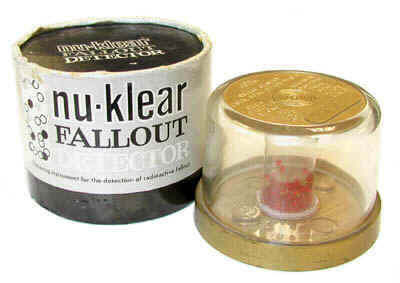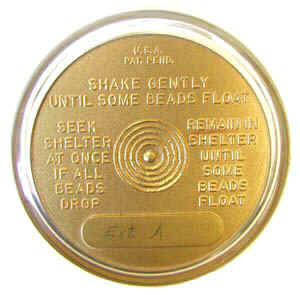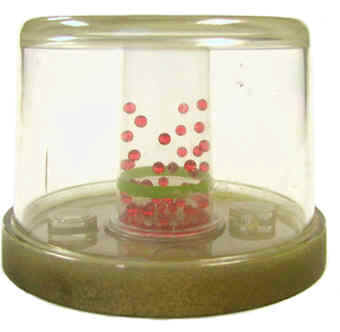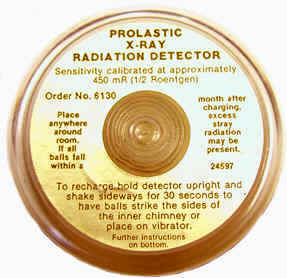Nu-Klear Fallout Detector (ca. 1962-1968)


You've got to love the Nu-Klear (aka NuKlear) Fallout Detector, "a life saving device for the detection of radiation from fallout." The body of the detector is a hermetically sealed clear plastic container (2.5" high and 3.75" diameter at the base). Inside is a clear central cylinder that contains about 40 small red plastic beads. By shaking the unit, the plastic beads are given a static charge that causes them to attach to the inside of the cylinder. Subsequent exposures to radiation would ionize the air inside the device and this would reduce the charge on the beads. When they lose their charge, the beads fall down to the bottom of the cylinder. The faster this occurs, the higher the radiation levels. For example, one company statement indicated that all the beads would fall to the bottom of the central tube within 15-20 minutes at 3R/hr and 15-20 seconds at 90 R/hr.

Following a nuclear confrontation, the instructions recommend leaving the detector just outside the fallout shelter exit for five minutes. If the beads have not all fallen to the bottom during that time, "you may risk exposure for a few minutes if you are faced with an emergency that cannot wait another day." Text on the bottom of the unit refers to Minutemen Industries Inc. of Chicago. However, the company identified in the instruction pamphlet and on the cardboard box, is the Alodan Corporation of Springfield Illinois. Another example of the detector, not in the collection, had a removable label on it that read "The Dr. Henry L. Richter Corp. Nu-Klear Div. Dept. RI [?], BIN 5 Pasadena, Cal 91109."
Leo Hoegh
It seems likely, but is not certain, that Leo Hoegh, one-time Governor of Iowa and Director of the Office of Civil and Defense Mobilization (OCDM), was the first to manufacture the NuKlear Fallout Detector - from 1962 until 1967 or so. During this time, it seems to have been marketed by several companies in the Midwest, primarily Illinois. Whether or not Hoegh actually created the device is not clear - I could not find the patent.
Henry Richter
In his autobiography, “America's Leap Into Space: My Time at JPL and the First Explorer Satellites” (2015) Henry Richter states that he purchased the patent and steel dies for the NuKlear Fallout Detector from Hoegh, This would have been in 1967, just as Richter was being laid off from UCLA due to budget cuts, Dipping into his savings, he formed the Dr. Henry L. Richter Company and soon “made a couple thousand of the devices.”
Quoting his autobiography:
”My advertising guy wanted to do some test marketing and chose ads in the Fresno Bee [Nov. 12, 1967] and a Sacramento Newspaper [probably means the San Francisco Examiner Nov. 12, 1967]. . . We did not get even one order! Not one! I couldn’t believe it!”
Ultimately, Richter managed to sell a few hundred, but that was it. What eventually happened to the patent, the dies and the unsold detectors is not known.

Prolastic X-Ray Detector
The ORAU collection has a device, nearly identical to the NuKlear Fallout Detector, called the "Prolastic X-ray Radiation Detector." It came from a chiropractor's office in California. As the instructions indicate, it evaluated stray radiation around X-ray units: "place anywhere around the room. If all balls fall within a month after charging, excess stray radiation may be present."
Nothing on the detector or in its instructions identify the manufacturer or distributor. However several publications reference the detector and/or the Prolastic Company (e.g., Los Angeles Times, August 12, 1979; Quintessence International Dental Digest, 1979). All date from 1979 -1981. The company, based in Rochester N.Y., seems to have specialized in dental products. How they obtained or manufactured the detectors is unknown. Perhaps they purchased them from Henry Richter?
Similar Devices – The Gamma Gauge and the Failla Cocktail
In 1969, Cresson Kearny, creator of the Kearny Fallout Meter (KFM), described a simple home-made version of the Nu-Klear Fallot Detector that could be employed for civil defense purposes (“The Gamma Gauge” in “Annual Progress Report. Civil Defense Research Project.” March 1969 – March 1970. ORNL-4566 Part 1. 1971). The key feature of the “gamma gauge” was that its charged beads were more numerous and smaller than those of the Nu-Klear Fallout Detector. But, as Kearny would later admit, his gamma gauge had problems.
Gino Failla was the first to conceive the idea of determining a radiation exposure via the rate at which multiple charged spheres move together. His “Failla Cocktail” employed small plastic beads floating on the convex surface of water in a cocktail glass. When the beads were charged, they repelled each other and separated. As the “cocktail” was exposed to radiation, the charge on the beads decreased causing the beads to move together at the apex of the water surface. The rate at which the beads moved was a measure of the radiation exposure. Failla’s wife, Pat, told me how her husband dragged her from one toy store to another buying baby rattles so he could find the best beads for his cocktail.
Advertisement
The following advertisement (date unknown) describes the purpose and design features of this device:

